Lizard Peninsula Location Guide
Well-known for its scintillating walks, sparkling shores and precious habitats, Cornwall’s Lizard Peninsula remains one of the UK’s most iconic seascapes.
This beautiful coastal sweep is home to a myriad of rare flora and fauna, recognised by Natural England as a National Character Area and Nature Reserve. It’s also one of Cornwall’s Areas of Outstanding Natural Beauty, playing host to Britain’s most southerly point.
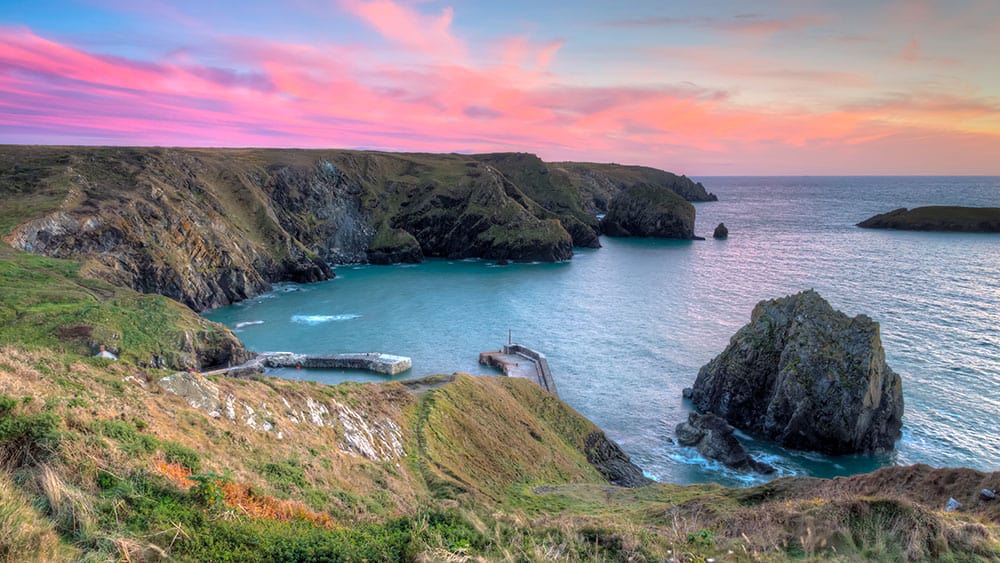
Wildlife enthusiasts flock to the clifftops of Lizard Point, binoculars poised and on the lookout for basking sharks, grey seals, porpoises and dolphins, while enjoying the far-reaching tracks and trails that cross stitch the reserve from Mullion Cove in the west, across the Goonhilly Downs, to Lowland Point in the east.
The Lizard rock formations were formed 400 million years ago, when part of the ocean crust known as ophiolite thrust above sea level, exposing rocky seams of green and red, the hallmark of serpentinite minerals common to this coastal corridor.
Lizard Peninsula’s Beautiful Beaches
Kynance Cove
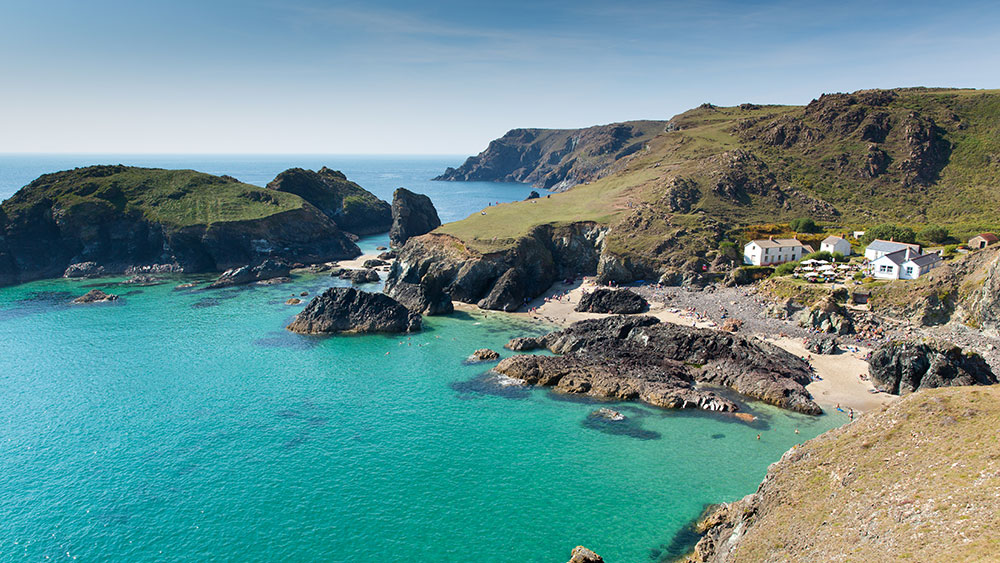
On a sunny day, the clear, turquoise waters of Kynance Cove present a scene reminiscent of the Caribbean, such is its brilliance. Used as a location for the BBC primetime Poldark series, it’s been a popular bathing spot since the Victorian era , it’s striking views, rugged outcrops and secret caves making it one of the Lizard’s more characterful shores. The beach café has been up and running for more than a century, a much-loved “off-grid” outlet championing local growers and traditional Cornish delights. Owned by the National Trust, Kynance is loved by coastal walkers and wild swimmers alike.
Pentreath Beach
Close to Kynance, found only by way of the coast path, Pentreath Beach is a pebbly shore with a sandy strandline and rockpools revealed at low tide. Another of the Lizard’s wonderful snorkelling beaches, you’re likely to spot all sorts of marine life in and around the rocky seabed. Surfers enjoy the Atlantic swells which often throw up some big funnels. The steep and scrambly path makes this beach hard to get to and not suitable for young families, and for that reason you’ll often find it deserted, even during the summer months. The cove also has its own shipwreck, the steam trawler “Maud”, wrecked here in 1912. Dogs are allowed on the beach all year round.
Housel Bay
Housel Bay is a secret cove hidden behind the towering headland of Lizard Point. Gin clear shallows and soft, white sand lie at the foot of these dark green serpentine cliffs that shelter the cove from the wild Cornish weather. One of the Lizard Peninsula’s lesser-known beaches, the bay is submerged by the incoming tide and found via a steep path that branches off from the main coastal trail.
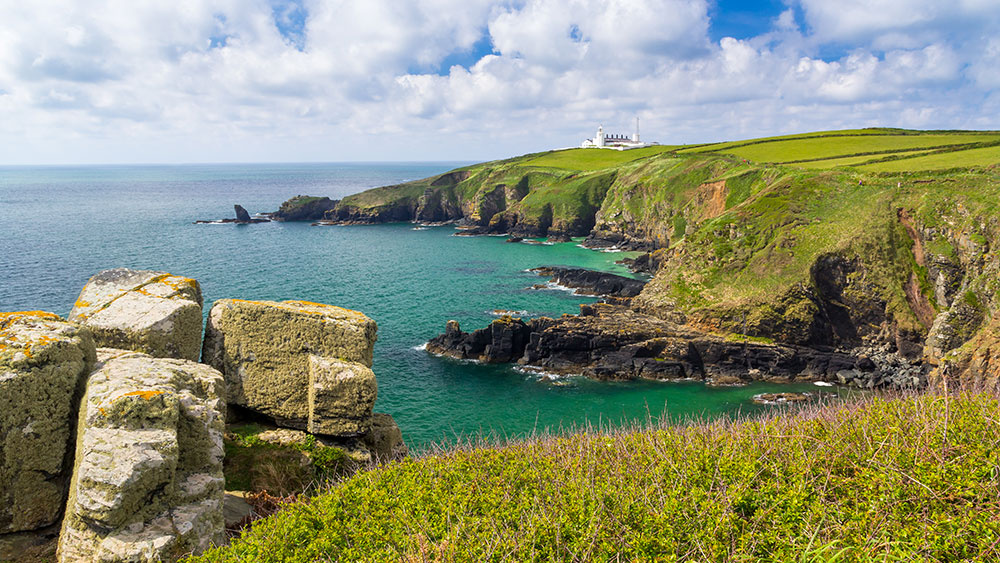
Church Cove
Further around the point lies Church Cove, a narrow, sandy beach revealed by the ebbing tide and below a historic slipway serving a local fishing fleet. Teeming with marine life, these rocky shores and sparkling waters provide the ideal combination for divers and snorkellers.
Polpeor
A tiny cove on the site of the old Lizard Lifeboat Station and slipway, Polpeor can be found along the South West Coast Path and is admired for its wonderful views. Dogs are welcome on the beach all year round, a good place to cool those paws after a hot day on the coastal trails.
Cadgwith Cove
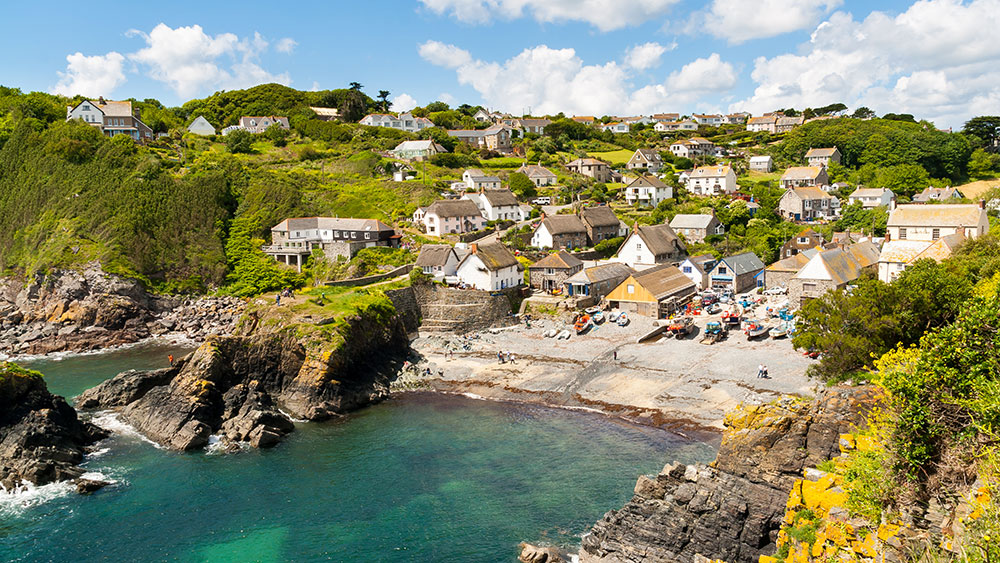
At the bottom of a small vale, beyond the rooftops of the village, lies Cadgwith Cove. This small shingle shore is overlooked by a characterful, tufted outcrop, where walkers can throw down a picnic blanket and enjoy a well-earned rest. Not far away is the fabled landmark known as the “Devil’s Frying Pan”, a collapsed sea cave 200 feet deep where the waves can come crashing in.
Caerthillian Cove
Another of the Lizard’s secret, rocky shores, Caerthillian Cove is a popular vantage point to rest during a coast path walk and enjoy the sparkling ocean views beyond the rockpools. Birdwatchers particularly love this stretch of the Lizard Peninsula as it’s home to the rare but iconic bird, the Cornish chough, which features in the county’s coat of arms. Caerthillian is also a lesser-known surfers’ haunt.
Mullion Cove
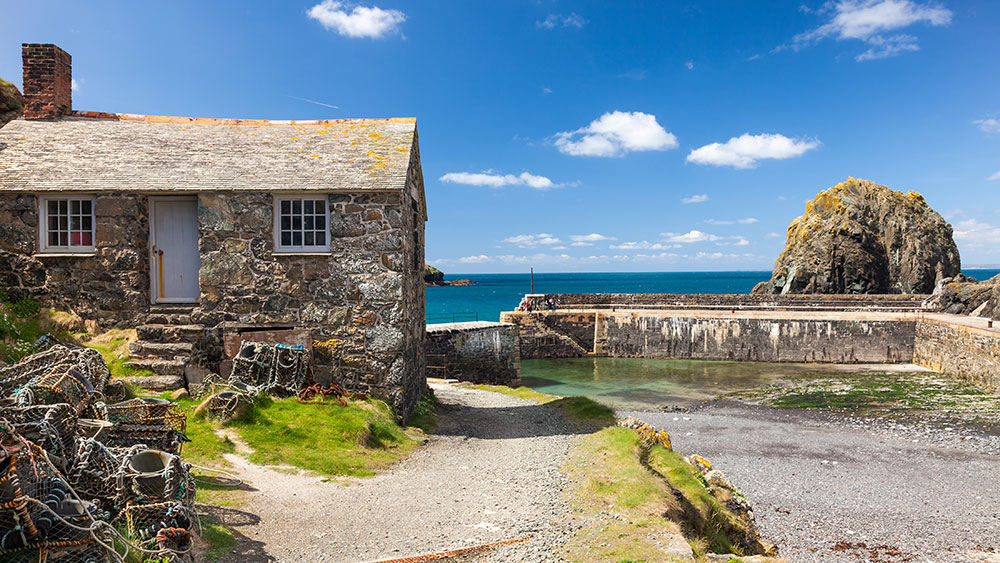
The ebbing tide reveals Mullion Cove’s pebble beach below the Victorian harbour walls made from Cornish granite. Cliffs tower above this sheltered shore and outcrops form a mini archipelago, a breeding ground for seabirds. The largest outcrop is known locally as “Mullion Island”, sculpted by prehistoric volcanic activity and shaped like a clover leaf. The old pilchard cellar standing on the quayside is a reminder of the cove’s once thriving fishing fleet. Owned by the National Trust, a small number of working boats continue to launch from the slipway.
Polurrian Cove
Further north, picking up the South West Coast Path, you’ll arrive at the golden sands of Polurrian Cove. Flanked by rocky cliffs, this sheltered shore gently shelves into the bay, great if you’re in the mood for a sea swim. A truly rural location, you’ll likely have the beach all to yourselves.
Poldhu Cove
From seaside solitude to arguably one of the most popular coves on the Lizard Peninsula. The soft sands of Poldhu Cove provide a wonderful family beach, backed by gradual sand dunes. The crystal-clear swells attract surfers keen to ride the legendry south coast rollers. For those looking to find their feet, the local surf school is a great place to start. Poldhu, which means “Black Pool” in Cornish, holds a special place in history as the site for inventor Guglielmo Marconi’s first transatlantic radio signal sent from a telegraph station on neighbouring Bass Point in 1901, considered by many to be the birth of modern radio. A small museum, run by the National Trust, exists there today to mark this groundbreaking event.
Gunwalloe
As the Lizard Peninsula weaves its final leg towards the sweeping coastline of Mounts May, we find two more of the region’s most celebrated coves. Surrounded by dunes and grassy tussocks, Gunwalloe boasts honey-coloured sand. The beach is named after the 5th century St Winwaloe’s church nestled into the northern fringes, recognised by its unusually squat bell tower. Often exposed to the Atlantic sea, it earned the name “Church of the Storms”. Seasoned surfers enjoy pitting their wits against the swells, but swimming here can be choppy. Lifeguards patrol the beach during the summer months and the stream that flows across it provides endless fun for paddling and dam building.
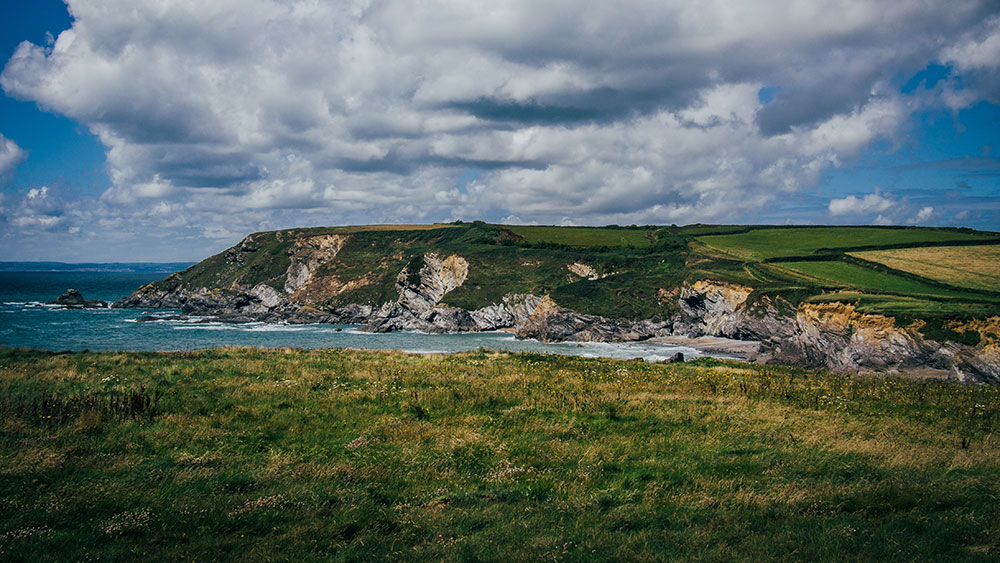
Dollar Cove
Metal detectorists travel from far and wide to visit Dollar Cove, found around headland and rumoured to have sunken Spanish treasure washed up on its shores. The clue is in the name, and the silver dollars that have been found close to the wreck of a 17th century galleon. Geologists also marvel at the packed strata that forms the cliffs that surround the cove, the result of eons of tectonic activity.
Carleon Cove
History books describe Carleon Cove as a thriving port, pilchard fishery and cellars, later to become a serpentine factory to be buffed and polished for jewellers. Some of the ruins remain, like the circular dry-stone tower which housed the old hauling capstan. The cove and valley is sure to pique the interest of geologists and wildlife enthusiasts.
Kennack Sands
Also found along the more sheltered eastern return of the Lizard Peninsula is Kennack Sands, a beautiful swathe with ample space for beachgoers to enjoy. One of the Lizard’s most popular family beaches, it’s surrounded by majestic headland and adjoins a designated nature reserve. Fledgling surfers find their feet on these calmer waters. The shoreline is halved by the incoming tide and a rocky outcrop known locally as the “Caerverracks” provides a great place for rock pooling. The eastern side of the beach is open for dogs to scamper. History buffs will notice the pill boxes cleaved into the surrounding hillside and anti-tank wall running along the rear of the beach, remnants from WWII.
Lankidden
Further along the coast path, on the Lizard’s eastern tail, is another of the peninsula’s hidden gems. Discovered via a steep and precarious path, Lankidden is a hidden cove far from the crowds. The cliff faces have seams of striking red serpentine streaked by igneous green gabbro, while on the surrounding slopes, the faint contours of an Iron Age coastal fort can be seen. Excellent for snorkelling, this quiet bay is also considered safe for experienced swimmers.
Walks Around the Lizard Peninsula
The Lizard Trail is considered one of the most majestic peninsulas in Europe. Its signature serpentine cliffs, far-reaching headland views and captivating wildlife continues to beguile our guests. Here’s a selection of popular walks for you to enjoy…
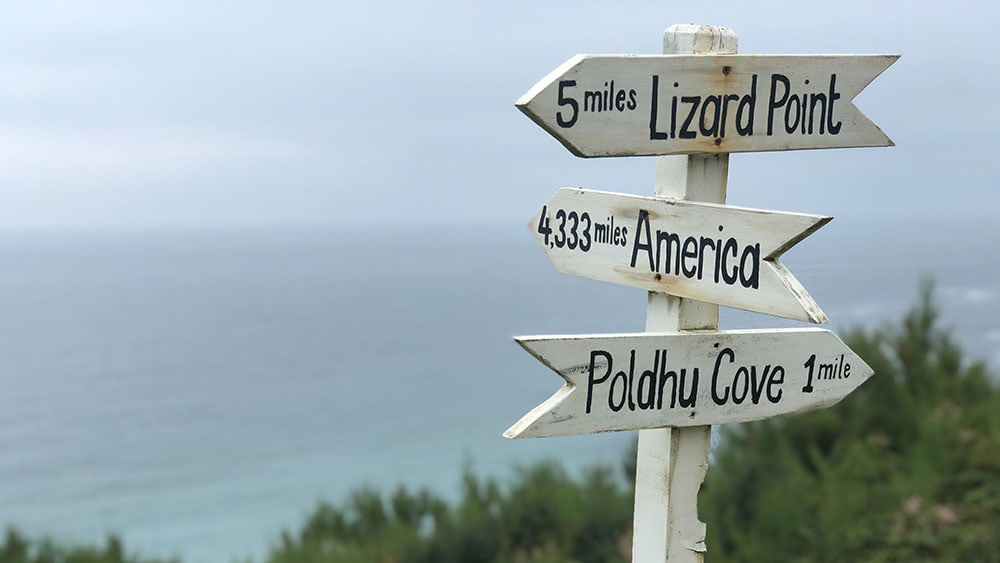
Every stile and waymark of the National Trust’s Lizard Peninsula Walk presents a stunning panorama and conjures fascinating coastal history. This 11-mile trail begins at the gleaming waters of Kynance Cove on the western tail, following the path past Lion Rock to the sands of Pentreath. Follow the world renowned South West Coast Path to Lizard Point Lighthouse, mainland Britain’s most southerly point, before traversing the Housel Cove, steeped in maritime history. The headlands of Pen Olver provide a wonderful picnic spot, an opportunity for some well-earned sustenance ahead of your return leg. From Bass Point the trail veers inland, guiding you to Lizard Village and back across the heart of the peninsula.
For a shorter circular route, follow the award-winning South West Coast Path’s Lizard Peninsula Walk, a four-mile trek along moderate terrain. Starting at the Lizard Village Green, enjoy a clifftop tour of the iconic Lizard Peninsula, wildlife in abundance at every turn. Follow the ancient drovers’ ways walking in the heroic footsteps of Poldark and exploring a series of historical sites of interest all the way to the secret shores of Housel Bay. This walk made ITV’s Top 20 Favourite Walks as voted by more than 8,000 ramblers and walking enthusiasts, the highest ranked West Country walk.
The team at iWalk Cornwall offer exceptional walking guides packed with local knowledge and history, also available via a handy smartphone app. Discover the Lizard Pensinula from top to tail and east to west. Most of these walks are classed as moderate terrain and range from between four and six miles.
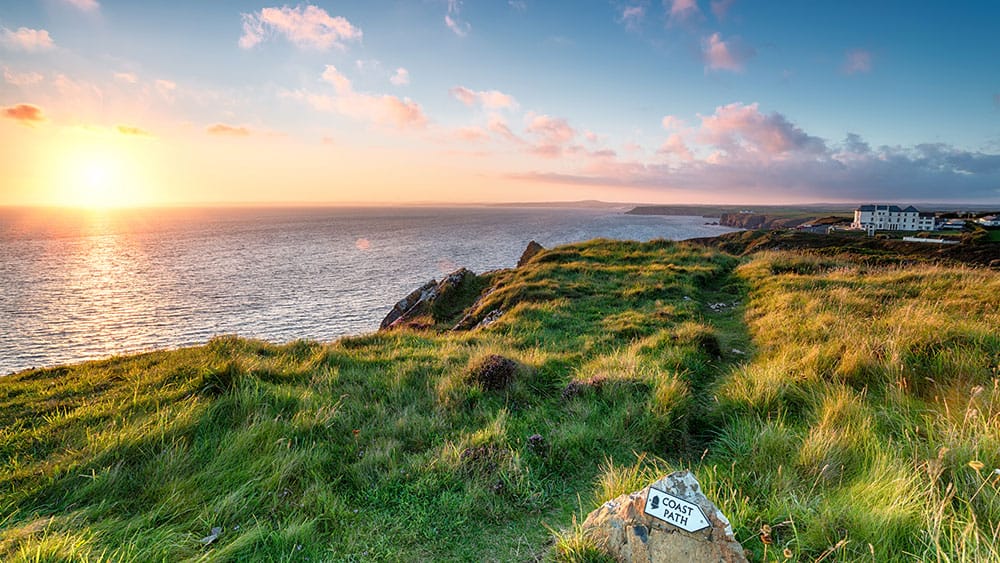
Places to Eat and Drink on the Lizard Peninsula
Nothing beats the welcome sight of a cosy coastal tearoom or country pub after a hearty yomp along the coast paths of the Lizard Peninsula.
Polpeor Café
Fancy a traditional Cornish cream tea or ample plate of fish ‘n’ chips at the most southerly café in mainland Britain? Look no further (you literally can’t look any further) than the Polpeor Café cooking up a storm in the kitchen from this most iconic spot. A great half-way pitstop for all those following the Lizard Trail.
Wavecrest Café
It can’t steal the most southward eatery accolade, but the Wavecrest Café can still boast fabulous panoramic views of Lizard Point and a fresh and seasonal menu packed with locally grown ingredients. You’ll find this friendly cafe at the head of the Kynance Cove coastal path, and despite its rural location, you can still hook up to superfast broadband to catch up on those Cornish weather forecasts and see where the surf is up.
Housel Bay
Elegant gastronomy and a true taste of Cornwall await all those dining at the Housel Bay Restaurant found set into the clifftops. Expect exquisite dishes accompanied by fabulous bayside views, the perfect setting for a romantic evening or special occasion.
Ann’s Pasties
Lizard village plays host to a handful of charming cafés and bistros, attracting a steady stream of hungry coastal ramblers. If you’re feeling famished, head to Ann’s Pasties for one of the county’s most famous savoury snacks. All the ingredients are grown and reared within a 10-mile radius of this perennially popular pantry. It’s as Cornish as they come!
Coast
Found in the heart of Lizard Village, Coast is a bustling bar and bistro with a sunny patio area and ample menu. Expect a warm reception at this family-friendly outlet where dogs are also welcome.
The Regent Bar & Grill
Flying the flag for local cuisine, The Regent Bar & Grill has a bumper menu for breakfast, lunch and dinner. Coastal walkers flock here, some sitting down to a light-bite or breakfast ahead of their adventures, others enjoying a hearty dish or local catch of the day having reached their journey’s end.
Lizard Seafood
Caught off The Lizard and landed at Cadgwith port, Lizard Seafood is an ever-popular venue serving fresh and tasty fish and shellfish. Keep an eye on the menu board to see the catch of the day and tuck in knowing that you’re supporting the livelihoods local fishermen.
The Witchball
They don’t come more steeped in history than the 15th century Witchball freehouse, Britain’s most southerly pub. This 600-year-old pub also runs a successful restaurant and has a lively social calendar which includes an annual music and beer festival. The bar is lined with local ales and the kitchen stocked with award-winning Cornish ingredients.
Smugglers Fish ‘n’ Chip Shop
Nothing beats the nation’s number one seaside dish, crispy battered fish and heaps of golden chips drenched in salt and vinegar. Head for the Smugglers Fish ‘n’ Chip Shop on Kynance Terrace, off Pentreath Lane, for a portion of this classic old favourite.
Ellie’s Soul Kitchen
Tucked away along the headland behind Pentreath Beach, ideally placed for walkers following the Lizard’s glorious coastal trails, Ellie’s Soul Kitchen is an “off-beat” caravan café serving up “travel inspired food” fit for wayfarers and wanderers.
The Old Cellars
The Old Cellars is a characterful bistro found in one of the Lizard’s most beautiful corners, the old fishing village of Cadgwith on the east side of the peninsula, recognised by its thatched roofs and narrow, winding lanes.
Cadgwith Cove Inn
Also set in this idyllic spot, is the Cadgwith Cove Inn, open for lunch and dinner. This 300-year-old smugglers’ inn is a cherished outpost for ramblers exploring the ancient coastal trail and in need of some delicious pub grub.
